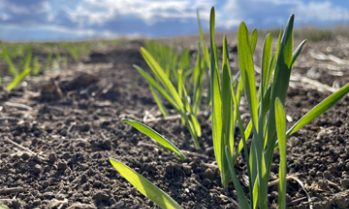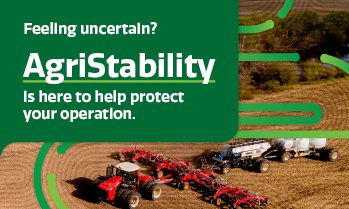FAQs
Get straight-forward, informed answers to your most important insurance questions.
Crop Insurance
-
Glad you asked...
Crop Insurance covers both production and quality. Your coverage is based on what you have grown over the long term and the coverage option you selected.
Please contact your local SCIC office or call us at 1-888-935-0000 to discuss the details of your farm's coverage.
-
Glad you asked...
Base price for most crops is based on Agriculture and Agri-Food Canada’s January price forecast for the upcoming year. Pedigreed, forage and organic crops have a separate price structure to reflect the value of these crops.
Producers have the option of selecting from a variety of price options, including: Base and Low Price Options, In-Season Price Option and Contract Price Option.
-
Glad you asked...
March 31 is the deadline to apply, reinstate, cancel or make changes to a Crop Insurance contract. This is also the deadline to select insured crops and coverage levels.
Don't wait until the deadline, contact your local SCIC office today to review all Crop Insurance options and select coverage best fit for your operation.
-
Glad you asked...
If you have a current Crop Insurance contact, you can access our online application CropConnect. Through CropConnect, you can enter insurance selections, add or delete crops, select options and choose coverage levels.
Access the online portal at: CropConnect or call us toll-free: 1-888-935-0000 for more details.
-
Glad you asked...
Starting in 2023, an Individual Premium is calculated for each crop a producer insures through the Crop Insurance Program.
Crop Insurance customers will see an Individual Premium for each crop based on personal claim history compared to the claim history of other producers of the same crop, within the same area (risk zone).
-
Glad you asked...
Individual Premium is individually adjusted for each crop based on your risk directly compared to the loss history of the risk zone. Your risk is measured by comparing your total claims (since 1998) to your total premiums over the same period, for each specific crop.
This individual risk compared to loss history of the risk zone determines an Individual Premium adjustment up or down from the risk zone base premium.
To learn more about your specific Individual Premium, please contact your local SCIC office or request a call back.
-
Glad you asked...
Saskatchewan is divided into 23 grain risk zones and 17 forage risk zones. The areas in each risk zone have similar crop production risks, which are used to determine the premiums a producer pays and the coverage they receive on their crops. Risk zones are determined by grouping areas with similar soils, climate and growing conditions.
The risk zones for the respective crop (e.g., forage risk zones, soybean risk zones, etc.) are used for determining the Individual Premium on that crop.
-
Glad you asked...
SCIC has always used risk zones as a benchmark within the Crop Insurance Program. Comparing each farm to other farms in the area provides a more wholistic perspective of the seeding conditions, growing season and production. Claims and similar loss experience within the risk zone help offset large fluctuations in premium rates for each farm.
When the entire risk zone has a bad year (e.g., 2021 drought, frost, early snow fall), the Individual Premium calculation helps minimize the impact on premium. Since a producer's individual claim history is compared to the area risk zone history, widespread claims among the area will lessen the likelihood of the producer seeing a premium increase.
As there is a one-year lag when calculating Crop Insurance premium rates, the 2021 production is now used for 2023 premiums. While there was a large number of claims in 2021, the effects were widespread, and this is how Individual Premium’s comparison to the area risk zone helps offset the impact of those claims.
-
Glad you asked...
For producers participating in Crop Insurance, the Seeded Acreage Report is necessary to calculate your level of insurance and process your claims. You must submit a Seeded Acreage Report declaring your seeded acres no later than June 25.
You do not have any Crop Insurance coverage until you report your acres on your Seeded Acreage Report. If you suffer a crop loss and have not reported your acres by June 25, your claim may be denied.
Seeded Acreage Report forms will be mailed to you in May. You can phone, fax, or mail your Seeded Acreage Report to any SCIC customer service office or you can use CropConnect to complete personalized reports online. If you fail to submit or are late, you may be assessed a penalty of $60. If necessary, an adjuster will visit your farm to gather the required additional information at an additional charge.
-
Glad you asked...
The Unseeded Acreage (USA) feature is included with multi-peril insurance coverage. All Crop Insurance customers have this protection for land too wet to seed due to excessive spring moisture.
If you are experiencing wet acres this spring, you can file a Unseeded Acreage claim by June 25. Submit the claim through your CropConnect account or by speaking to your SCIC office.
For more information about your Crop Insurance coverage or to file a Unseeded Acreage claim, contact your local SCIC office or call us at 1-888-935-0000.
-
Glad you asked...
Crops that fail to adequately establish or suffer significant damage due to insurable causes before June 20 are eligible for an establishment benefit. Click here to learn more.
-
Glad you asked...
Fall crops seeded by September 30, and insured for yield-loss by March 31 of the following year, will be covered for spring-related establishment losses that are not winterkill related.
-
Glad you asked...
When selecting your Crop Insurance coverage, you have a determined production guarantee and a designated grade for the crop you are insuring.
To determine the amount of compensation for quality loss, SCIC uses a formula that makes up the difference between the value of the harvested production and the value of the designated grade for the insured crop. The difference is known as a quality factor and this factor is applied to the harvested production when calculating the final Crop Insurance payment.
-
Glad you asked...
Absolutely! SCIC encourages producers to consider participating in both Crop Insurance and AgriStability Programs as part of a comprehensive risk management plan for their farming operation.
With Crop Insurance, you have coverage for your crops from the start of seeding season until harvest is complete. Through AgriStability, you have even further coverage for other uncontrollable events throughout the year (such as rising input costs, falling commodity prices or unforeseen additional expenses. Since AgriStability accounts for the whole farm, the Program can provide benefit payments even if you also receive a Crop Insurance payment.
Click here to to find the right coverage for your operation.
-
Glad you asked...
Crop Insurance customers who selected the Forage Rainfall Insurance Program (FRIP) have coverage against dry conditions and fire. FRIP customers can manage and graze their grass as needed.
For weather derivative programs, claims do not have to be filed; they are automatically calculated based on weather station data.
-
Glad you asked...
Clubroot is an important soil-borne disease that has the potential to impact yields on cruciferous crops (canola, mustard, etc.). Crop rotation is key to minimizing the impact and incidence of this disease. SCIC is working with the Ministry of Agriculture to inform Saskatchewan producers about the importance of rotation to manage clubroot. In some cases, if producers continue growing canola on the same land location and suffer a loss, their coverage may be reduced or denied.
-
Glad you asked...
Yield trending recognizes agronomic and production advancements and increasing a producer’s historical yields. Agronomic advancements may include improved farm management practices, technology, equipment and new crop varieties.









